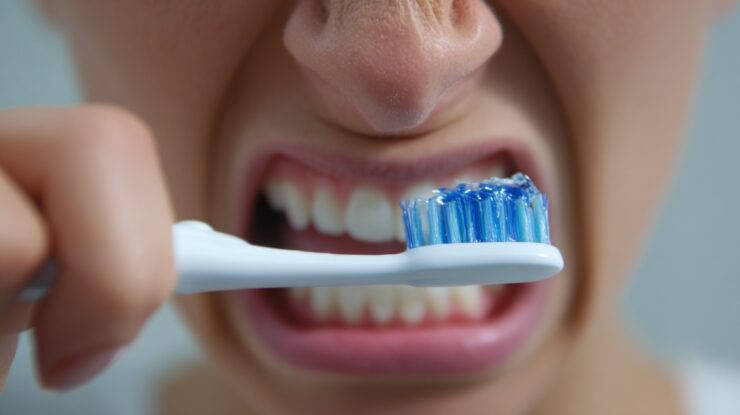Many people notice a bit of pink in the sink while brushing and dismiss it as harmless.
That tiny streak of blood is often a quiet cry for attention.
Bleeding gums are not a trivial occurrence but a warning sign that something is wrong in the mouth or even elsewhere in the body.
Healthy gums do not bleed easily, and ignoring this symptom can lead to more serious oral and systemic issues.
Let us take a look at what health problems bleeding gums can cause and what causes this issue in the first place.
Systemic Health Risks
Gum health plays a significant role in overall well-being.
When gum disease progresses, bacteria and inflammation can travel through the bloodstream, impacting various organs and systems in the body.
Several serious health risks are linked to gum inflammation and infection.
Heart Disease
View this post on Instagram
Inflamed gums are a hidden risk factor for cardiovascular complications.
Oral bacteria can enter the bloodstream through small tears in gum tissue and attach to arterial walls, contributing to plaque buildup and narrowing of blood vessels.
The resulting inflammation puts additional strain on the heart and circulatory system.
Studies have shown a correlation between periodontal disease and an increased risk of heart attacks and strokes.
Managing gum health can therefore reduce cardiovascular strain.
- Maintaining daily brushing and flossing routines
- Scheduling professional dental cleanings
- Managing blood pressure and cholesterol levels
- Avoiding smoking, which accelerates arterial damage
Taking care of gums can, in turn, protect the heart and prevent chronic inflammation that leads to more severe conditions.
Diabetes

A strong, two-way relationship exists between diabetes and gum disease.
Elevated blood sugar levels encourage bacterial growth in the mouth, making gums more prone to infection.
In return, gum inflammation can increase insulin resistance, making blood sugar harder to control.
Individuals with diabetes often experience delayed wound healing, which allows gum infections to persist longer.
Proper management of both oral hygiene and blood glucose levels is essential to break this harmful cycle.
- Frequent dental checkups for early detection of gum inflammation
- Regular brushing and flossing to reduce bacterial load
- Consistent monitoring of blood sugar levels
- A balanced diet that supports both gum and metabolic health
Addressing gum health is a vital component of diabetes management and can prevent further complications in the body.
Respiratory Issues

Bacteria originating in the mouth can easily enter the respiratory tract, especially in individuals with existing lung conditions.
Once inhaled, these microorganisms can trigger respiratory infections or worsen chronic illnesses such as bronchitis or chronic obstructive pulmonary disease (COPD).
Poor gum health creates a constant bacterial source that may compromise lung function.
Maintaining oral hygiene minimizes bacterial presence and lowers infection risk.
- Regular dental checkups for professional cleanings
- Proper daily brushing to limit bacterial accumulation
- Avoiding smoking and exposure to air pollutants
- Keeping nasal passages and the oral cavity hydrated to discourage bacterial colonization
Healthy gums play a surprising yet essential role in protecting respiratory health.
Pregnancy Complications

Hormonal and immune changes during pregnancy can increase the likelihood of gum inflammation.
Bleeding gums, if left untreated, may lead to periodontal disease, which has been associated with preterm births and low birth weight.
Inflammatory molecules produced in the gums may affect fetal development and trigger early labor.
Protecting oral health during pregnancy is an important part of prenatal care.
- Visiting a dentist early in pregnancy for assessment
- Brushing twice daily with fluoride toothpaste
- Eating a balanced diet rich in vitamins and minerals
- Avoiding tobacco and alcohol products
Good oral care supports a healthy pregnancy and contributes to safer outcomes for both mother and child.
What Causes Bleeding Gums?
Bleeding gums are a signal that oral tissues are in distress.
They rarely occur without a cause, and understanding the triggers can help prevent more serious dental and health complications.
Gum bleeding is often the result of poor hygiene habits, nutritional deficiencies, or underlying medical conditions.
Recognizing these causes early ensures effective intervention and healthier gums in the long run.
Gum Disease (Gingivitis & Periodontitis)
View this post on Instagram
One of the most common and dangerous causes of gum bleeding is gum disease.
It begins as gingivitis, a mild inflammation caused by bacterial plaque buildup along the gumline. Plaque, when not removed regularly, hardens into tartar and irritates gum tissue.
Early symptoms include tenderness, redness, and bleeding during brushing.
If untreated, gingivitis can progress into periodontitis, an advanced form of gum disease where the infection reaches the deeper supporting tissues.
In this stage, gums start pulling away from the teeth, forming pockets that harbor bacteria. Bone deterioration may follow, eventually leading to tooth loss.
- Gingivitis: Mild inflammation and bleeding that can be reversed with improved hygiene.
- Periodontitis: Irreversible damage involving gum recession and bone loss.
Preventive care such as professional cleanings and consistent oral hygiene remains essential for avoiding progression. Dentist clinics like Tannlegeteam offer dental care appropriate to the individual needs, helping patients manage and treat early signs of gum disease before it leads to more serious complications.
Poor Oral Hygiene

Inconsistent oral hygiene is a leading cause of bleeding gums.
When brushing, teeth whitening, or flossing habits are irregular, bacteria and food debris collect around teeth, creating a breeding ground for plaque.
Over time, this buildup triggers inflammation and infection.
Daily cleaning prevents bacteria from maturing into harmful colonies that attack gum tissue.
- Brushing at least twice daily using fluoride toothpaste
- Flossing once per day to remove plaque between teeth
- Regular dental checkups for professional cleaning
Consistent oral hygiene helps maintain balanced bacterial levels and keeps gums firm and pink.
Aggressive Brushing or Hard-Bristled Toothbrush

Many believe that brushing harder means cleaner teeth, but aggressive brushing often has the opposite effect.
Harsh brushing or using a hard-bristled toothbrush can physically damage the delicate gum tissue and enamel.
The result is inflammation, bleeding, and increased sensitivity.
Dentists recommend switching to a soft-bristled toothbrush and using small circular motions when brushing.
Gentle yet thorough cleaning effectively removes plaque while keeping gums intact.
Electric toothbrushes with pressure sensors can also assist in preventing excessive force during brushing.
Vitamin Deficiencies

Nutritional balance plays a critical role in oral health. Deficiencies in key vitamins weaken gum tissues and reduce their ability to heal properly.
Two vitamins in particular, Vitamin C and Vitamin K, are vital for maintaining gum integrity.
- Vitamin C deficiency leads to weakened connective tissue, slow wound healing, and increased gum bleeding.
- Vitamin K deficiency interferes with blood clotting and makes gums more susceptible to bleeding.
Adding foods such as oranges, bell peppers, spinach, and broccoli into daily meals supports gum resilience and reduces inflammation.
Supplements may also be considered under medical guidance.
Hormonal Changes

Hormonal fluctuations during puberty, menstruation, pregnancy, or menopause can increase gum sensitivity.
In particular, pregnancy-induced gingivitis affects many expectant mothers, often appearing during the second or third trimester.
Hormonal shifts increase blood flow to gum tissues, which heightens their reaction to even minor plaque accumulation.
- Maintaining a consistent oral hygiene routine
- Visiting a dentist for regular cleanings
- Eating nutrient-rich foods that support gum strength
- Using a soft-bristled toothbrush to minimize irritation
Pregnant individuals should be especially vigilant with oral care, as gum disease has been linked to pregnancy complications.
Medication Side Effects

Certain medications alter the body’s natural ability to protect and heal gum tissue.
Blood thinners such as warfarin or aspirin can make gums more prone to bleeding, while some antihypertensives, antidepressants, and oral contraceptives may affect gum response to bacteria.
- Inform their dentist about all prescribed drugs
- Use an antibacterial mouthwash to control bacterial buildup
- Follow a consistent oral care routine to reduce irritation
Professional advice is essential before making any changes to medication.
A dentist can coordinate care with a physician to manage oral side effects effectively.
Early Signs and Symptoms to Watch For
Bleeding gums are often one of the first warning signs of oral disease.
However, several other subtle symptoms may indicate trouble before pain or discomfort sets in.
Recognizing these signals allows for early intervention and better recovery outcomes.
- Frequent gum bleeding while brushing or flossing
- Redness, swelling, or tenderness in gum tissue
- Receding gums that make teeth appear longer
- Persistent bad breath or an unpleasant taste in the mouth
- Tooth sensitivity and looseness caused by weakening gum support

Even mild symptoms should never be dismissed.
Early professional evaluation helps prevent the need for advanced treatments such as scaling, root planing, or surgery.
Summary
Bleeding gums should never be ignored.
They often indicate underlying problems that, if addressed early, can prevent significant complications.
Consistent oral hygiene, balanced nutrition, and professional dental care form the foundation of healthy gums and a healthy body.
A simple reminder holds true: your gums do not bleed without a reason.
Listen to them and act promptly to protect both oral and overall health.
Read more: What can you eat after wisdom teeth removal? Find out here!

